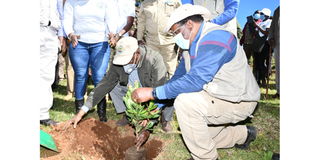State follows in UN footpath by launching ambitious ecosystem restoration plan

Environment Cabinet Secretary Keriako Tobiko and a Kenya Forest Services official plant a tree at the Maasai Mau Forest during an event to mark the first anniversary of restoration efforts, October 31, 2020.
The government has reaffirmed its commitment to restore 5.1 million hectares of deforested and degraded land under the African Forest Landscape Restoration Initiative (AFR100), a country-led effort to bring 100 million hectares of land in Africa into restoration by 2030.
Speaking at Garissa University on Saturday, June 5, Environment Cabinet Secretary (CS) Keriako Tobiko launched the "Decade of Ecosystem Restoration 2021-2030" in line with United Nation's ambitious agenda to bend the curve of nature loss.
"It is not sufficient to plant trees for the cameras. It is more important to ensure that each is grown, nurtured. Every member of this university should adopt one tree and ensure that they grow until they are fully established," the Environment CS Tobiko said after leading a tree-planting exercise at the university.
The Environment CS, who called for concerted efforts to ensure a sustainable ecosystem, also led the ministry's stakeholders in planting trees in honour of the 148 students who lost their lives during the 2015 Garissa University terrorist attack.
With this year’s fete was themed “ecosystem restoration”, the annual event is set aside by the UN to promote worldwide awareness and action for the environment, and is locally coordinated by the National Environment Management Authority (Nema). The event brings together stakeholders from the private and public sector.
Speaking during the celebrations, World Wide Fund for Nature-Kenya Chief Executive Officer (CEO) Mohamed Awer said the conservation organisation is already implementing several ecosystem restoration projects around the country.
"The Kenyan government has committed to restore 5.1 million hectares of deforested and degraded land under the Africa Forest Landscape Restoration Initiative. At WWF-Kenya, we're already implementing a project to restore 30,000 hectares in Kwale County," said CEO Awer.
Mr Awer also revealed that WWF-Kenya has already launched two other projects to restore 900 hectares in Nyandarua County and 25,000 hectares in East Kilimanjaro in Loitoktok.
"We're starting another programme in East Kilimanjaro in Loitokitok as part of a four-country Africa programme to restore 100,000 hectares. On Friday, we launched a Forest Landscape Restoration project in Nyandarua County to restore 900 hectares. These small actions will add up to a bigger impact and we call upon other stakeholders to do the same," Mr Awer said.
According to National Environment Management Authority (Nema), reviving natural carbon sinks – such as forests and peat lands – could help close the climate emissions gap by 25 per cent by 2030.
Replanting with native tree species, Nema says, can also help buffer some of the expected devastating effects of a warming planet, such as increased risk of forest fires.
"Ecosystems support our life on Earth. The healthier our ecosystems are, the healthier we are. This is the time to commit to restore our ecosystems. We've pushed many ecosystems to the breaking point," warned Nema Director-General Mamo B Mamo.





